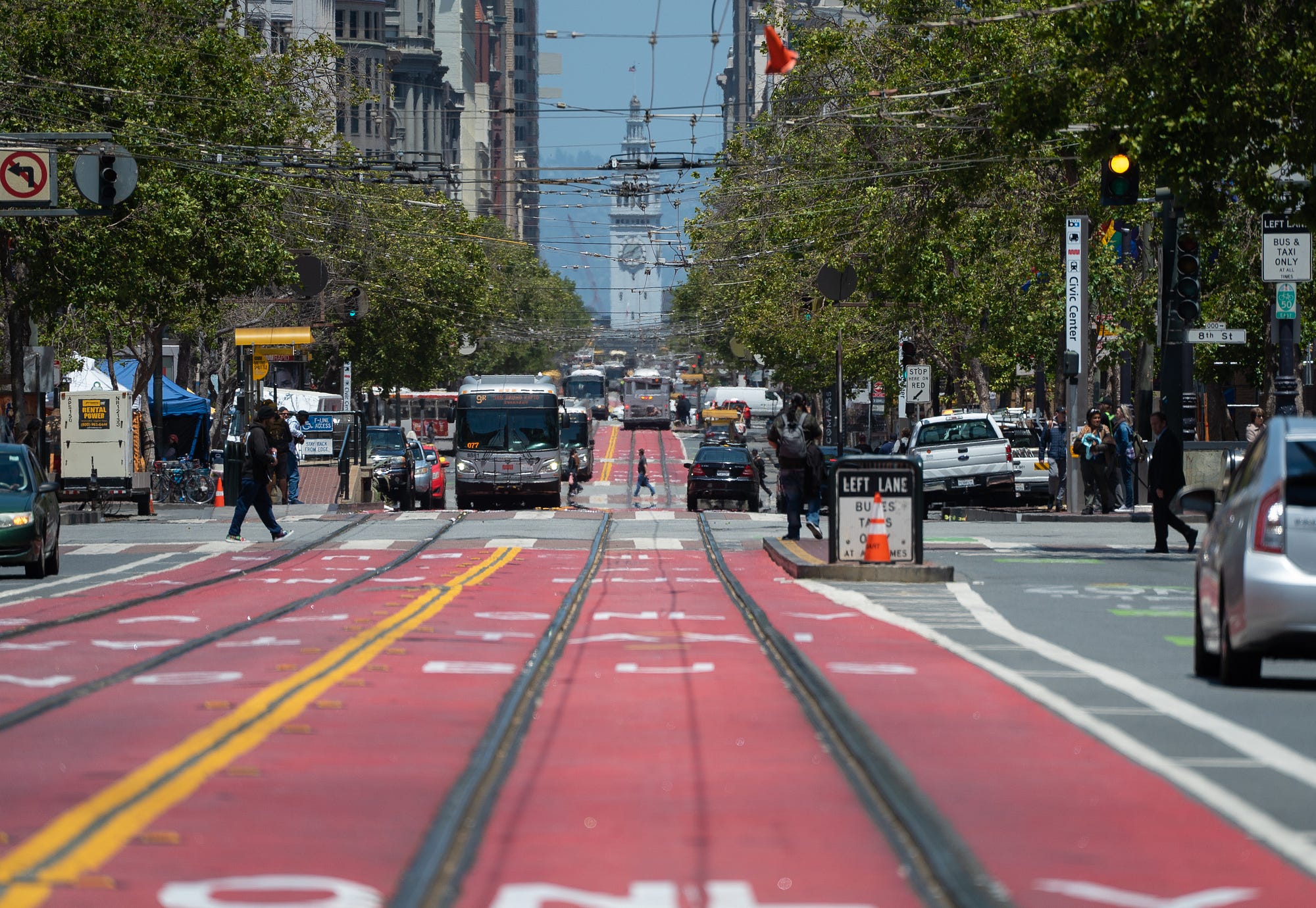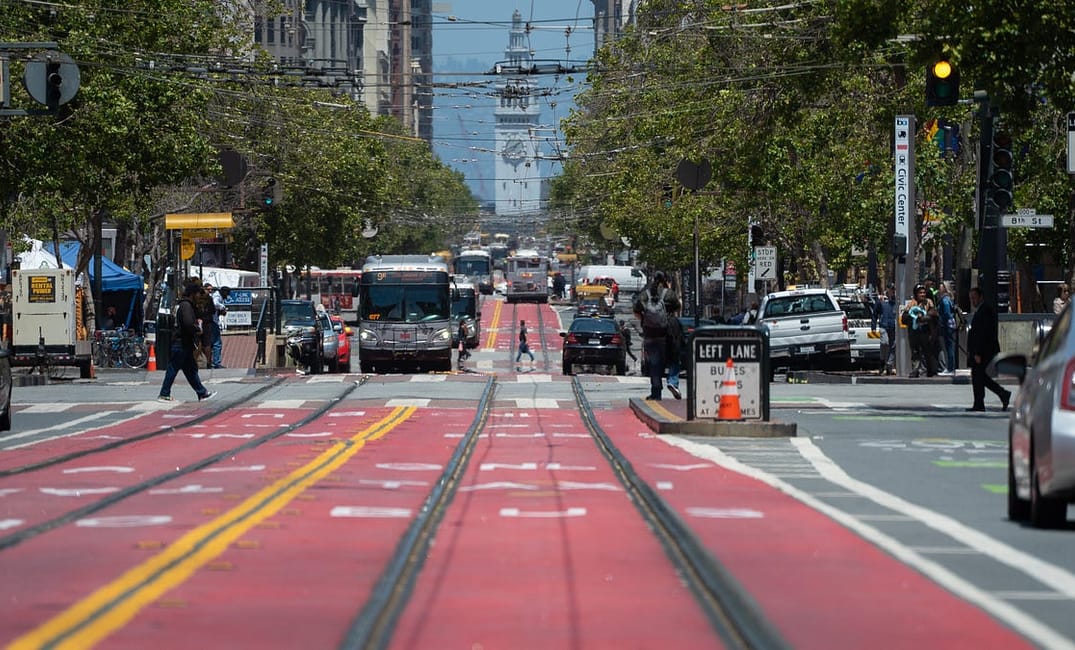
Market Street, San Francisco’s most-congested promenade, is finally going car free. The move is long overdue—as it stands, it’s one big confusing cluster of cars, bikes and pedestrians that makes up a perfect environment for accidents to happen. And they do: there were 123 injury collisions on the street during the last year alone.
Starting early next year, though, things will start to change under the Better Market Project (approved in October). Although it will take a few years to get the project fully up and running, many of the proposed changes are slated for early 2020, part of San Francisco’s Municipal Transit Agency (SFMTA)’s new “quick build” model. And the future of Market Street looks downright utopian, especially compared to its dangerous present.
The plan puts San Francisco at the forefront of what is now a worldwide movement towards car-free streets.
Once completed, more than two miles of the street will be closed to private vehicles, with only taxis and public-transit vehicles allowed. Ubers and Lyfts will have to stick to designated loading zones on side streets. Sidewalks will be extended, and transit connections to the area increased. Muni will have its designated lane in the center, while the outer lanes of the street will be reserved for Muni buses and commercial vehicles. New “bikeways” — raised bike lanes at the sidewalk level rather than the street level— will protect cyclists. Market Street’s main drag will be transformed into a more usable public space.
The plan puts San Francisco at the forefront of what is now a worldwide movement towards car-free streets—one modeled after European cities such as Oslo, Berlin, and Madrid that have shut down certain areas to vehicle traffic in an attempt to control emissions, reduce traffic injuries, and make city streets a more pleasant place to be. San Francisco is the second city in the United States to vote for a car-free major corridor — NYC was the first — but advocates are hoping that others will follow suit.
Citizens and transit advocates have pressured public officials to take action to make San Francisco’s streets safer. One group, the San Francisco Bicycle Coalition, has fought for a car-free Market Street for a decade. Led by the SFBC, hundreds of activists and community members spoke out at the October 15th SFMTA meeting where officials voted on the project.
“Let’s get cars off [Market] this year,” said SFBC staffer Charles Deffarges. “Let’s get bike lanes built starting next year. If we don’t, we won’t meet our goals. We are behind, and we need to do this.”
This shift has been long in the making: The city first flirted with a car-free Market Street under governor Gavin Newsom, and the Better Market Project as it is currently envisioned has been in development for about 10 years. It took so long partially because it is comprehensive. The project involves more than removing cars from the street; it also develops new solutions for transit and redesigns the structure of the street. One example is the creation of a new loop for the historic F-Market streetcar—rather than going all the way to the Castro, streetcars will now turn around on Market and return to Fisherman’s Wharf. But all those improvements involve trade-offs, like balancing space for pedestrians and increased transit options.
“You’re dealing with one of the only areas of San Francisco that actually has so much pedestrian activity that it’s bursting at the seams,” said Ben Grant, the urban policy director for the advocacy group SPUR. “Most of San Francisco doesn’t have that problem. That’s a New York City–type problem or a Paris-type problem. But for a few blocks in the heart of Market, we do have that problem. The trade-offs were really challenging.”
Market is a microcosm of traffic and vehicle issues all over the Bay Area—and all major cities, for that matter. For a place that prides itself on its progressive politics, San Francisco tends to still prioritize cars, sometimes over human safety. When I was growing up in the Bay Area, most of my friends and I got to school on bikes, skateboards, buses, or on foot, but it wasn’t easy. We often struggled with crossing busy streets and dealing with narrow bike lanes.
The Better Market project was slow to plan, but SF is still far ahead of the rest of the Bay. Our injury problem is region-wide; in 2016, nearly seven hundred people were injured in pedestrian-car or car-bicycle collisions in the Bay Area as a whole. Other cities in the Bay Area, especially Oakland, also have serious safety issues for bikers and pedestrians; about 350 people are hit by cars there every year.
Phoenix Mangrum, a bicycle advocate in the East Bay who works for Cycles of Change, a bike education group, says he “gets cussed out at least once a week by aggressive cars.”
Advocates like Mangrum would love to see a similar project replicated in Oakland. In the meantime, bikers like Mangrum keep trying to find workarounds. “I have to work with what is, right now. I can’t work with 20 years from now,” Mangrum said.
In the short term, cities may be able to temporarily close streets even if they can’t make them car-free permanently, thereby offering cyclists and pedestrians some relief during busy times.
“There are low-impact ways to do that without spending eight years. Every couple of months, Valencia gets closed without much fanfare, except that lots of people walk and enjoy that space,” said Warren Logan, the policy director of mobility and interagency relations for the City of Oakland.
All of this can sound theoretical, but collisions between people and cars can happen at any minute — and they do. During my sophomore year of high school, a friend of mine was riding her bike across the street to our school one morning. It was a busy intersection with a short walk signal. She was late to first period, she later told me, and she was thinking more about the tardy slip she would be getting than the road around her. She didn’t see the Suburban driving straight toward her — and in the morning fog, the driver must not have seen her either — and before either one of them could react, the car hit her, and she was thrown from her bike. She had a broken leg and more than her fair share of bruises.
Unfortunately, her story isn’t unusual. There are hundreds of car collisions involving bikers and pedestrians in the Bay Area every year — and some are fatal. The Better Market project will hopefully serve as a model not just for San Francisco, but the entire Bay Area and other cities throughout the country.







